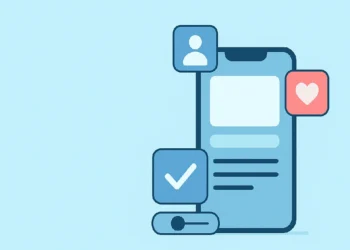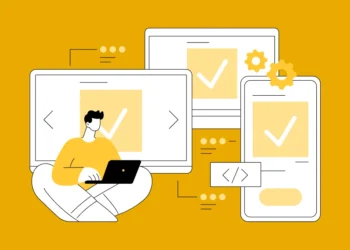Nowadays, we use web apps as a basic and essential tool. Businesses seek ways to provide better services, streamline processes, and reach wider audiences. The most powerful tool to achieve these goals in real-time web applications is here. But to build a successful web app, you can’t just rely on code; it’s a structured journey that needs planning, designing, developing, testing, and launching.
In this blog, we will discuss the basic steps and proper process for building a web app. Whether you are a business owner planning your first app or just a curious learner, understanding these steps will help you make smarter decisions and ensure consistent growth.
Step-by-Step Web Development: From Idea to Launch

Step 1: Research and Define Your Objectives
A successful app starts with solid research about your goals and needs. Before you begin designing or coding, the very first step is to understand a few things, like
- Who is your target audience?
- What problem will your app solve?
- What features are must-haves, and what are optional?
- What’s already available in the market (competitor analysis)?
These questions will help you clearly define your goals and expectations for your web app. This stage involves gathering information from users, stakeholders, and even clients. It helps create a clear vision and avoid confusion later on.
Step 2: Planning and Strategy
Once you are done finding your objectives and needs, it’s time to turn that data into a solid development plan. Without proper planning, no matter how good the idea or research is in your mind, if you can’t put the research into a proper plan to grow, there is no point and no chance to develop a successful web app.
In the 2nd step, this is exactly what you have to do:
- Define the tech stack (Frontend, Backend, Database, APIs)
- Create a feature list or product roadmap
- Break the app into modules or components
- Set timelines and milestones
- Assign responsibilities to team members
- Decide on development methodology (Agile, Scrum, Waterfall, etc.)
Step 3: UI/UX Design
After the planning, it’s time to give the design and visuals to your app. This step is all about creating a design that’s not just pleasant to the eyes but also user-friendly. A good UI/UX can make users fall in love with your app, while a complicated one can lose their interest.
What exactly to do in this step?
- Wireframes: Basic blueprints that show layout and navigation
- User Flow Mapping: Understanding how users will move through the app
- UI Design: Visual elements like colors, fonts, icons, and buttons
- Responsive Design: Making sure the app looks good on all screen sizes
- User Testing (Prototype): Get early feedback by testing clickable mockups
Step 4: Frontend and Backend Development
Now you are ready with your designs, so it’s time to turn the visuals into a fully functional web app. This step contains 2 major parts: the frontend, which users interact with, and the backend, which handles all the behind-the-scenes logic and data processing.
What to Include in This Step:
Frontend Development:
- Convert design mockups into actual web pages using HTML, CSS, and JavaScript
- Use frameworks like React, Angular, or Vue.js
- Ensure responsiveness and cross-browser compatibility
Backend Development:
- Set up server, database, and application logic
- Choose backend technologies like Node.js, Django, Laravel, or Ruby on Rails
- Develop APIs to connect the frontend with the backend
- Ensure security, authentication, and data handling
Step 5: Testing and Quality Assurance
Now your app is developed, but it’s important to test it thoroughly before going live. This will ensure that everything is working as expected and there is no loophole, no broken links, no bugs, and no user issues. Quality assurance improves user trust and reduces the chances of failure after launch.
What to Include in This Step:
- Functional Testing: Check if all features work correctly (buttons, forms, login, search, etc.)
- Usability Testing: Make sure the app is user-friendly and intuitive
- Compatibility Testing: Ensure the app works smoothly across different devices and browsers
- Performance Testing: Test speed, load time, and how the app performs under heavy traffic
- Security Testing: Check for vulnerabilities, especially in login, payment, and user data handling
- Bug Fixing & Re-Testing: Identify bugs, fix them, and re-test until the app is stable
Step 6: Deployment and Launch
Once the app is fully developed and tested, release it into the real world. Here, deployment means uploading your web app to a live server so users can access it online.
What to Include in This Step:
- Choose a Hosting Platform: Select cloud platforms like AWS, Google Cloud, Heroku, or Vercel
- Set Up the Server: Deploy the frontend and backend to the server
-
- Connect the database and configure the environment variables
- Domain Configuration: Set up your domain name (e.g., www.yourapp.com)
-
- Configure an SSL certificate for HTTPS security
- Final Testing (on Live Server): Test all major functions again to avoid live errors
- Go Live: Announce the launch via email, social media, or press
- Monitor real-time traffic and performance
Step 7: Maintenance and Updates
Now, as you have launched your app, it was not the end step; it’s just the beginning to keep your web app relevant. secure, bug-free, and updated; ongoing maintenance and regular updates are a must.
What to Include in This Step:
- Bug Fixes and Error Monitoring: Track and resolve issues reported by users or monitoring tools
- Performance Optimization: Improve loading speed, fix slow APIs, and reduce server load
- Feature Updates: Add new functionalities based on user feedback or business growth
- Security Patches: Keep libraries and frameworks updated
- Fix security loopholes regularly
- Backup and Recovery: Schedule regular backups to prevent data loss
Conclusion
Now we have understood that web development is not just about writing code; it’s a whole journey and has several steps to make a successful web app stand out in the market. It’s a journey that starts from identifying the right problem to solve, followed by detailed planning, design, development, testing, deployment, and finally, ongoing maintenance. Each step plays a critical role in building an app that is not only functional but also scalable and user-friendly.
No matter if you’re building your first product or looking to scale an existing one, following a structured process can save time, reduce errors, and ensure long-term success. Many businesses choose to collaborate with a mobile app development company in Bangalore. So, if you aim to create an impactful web app, teaming up with the best mobile app development company in Bangalore or anywhere else can help you turn your ideas into powerful, real-world solutions.

















